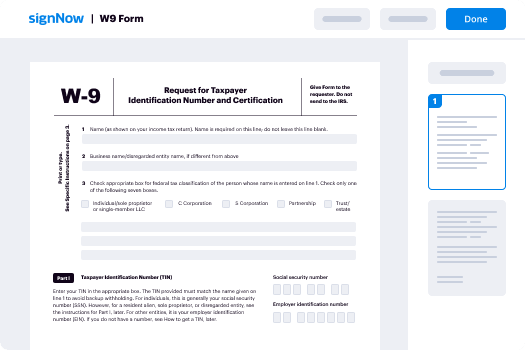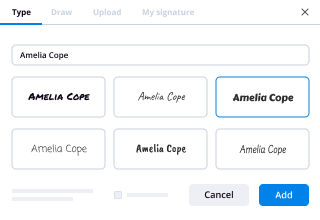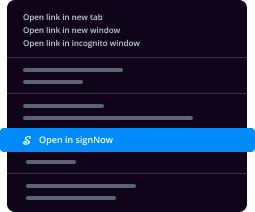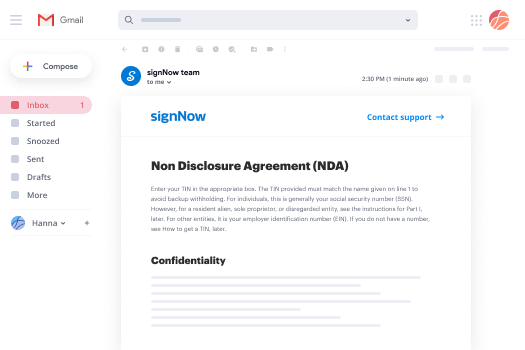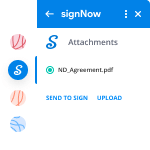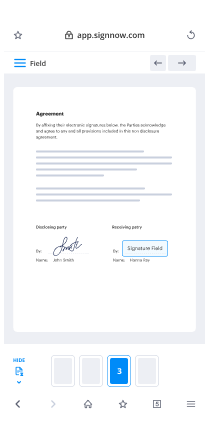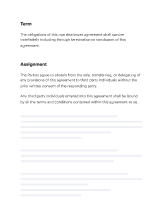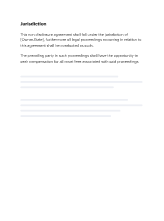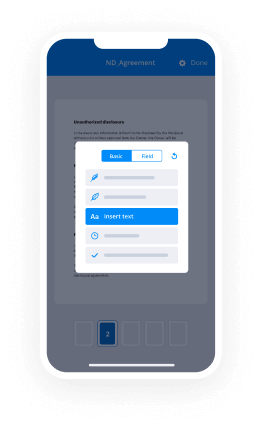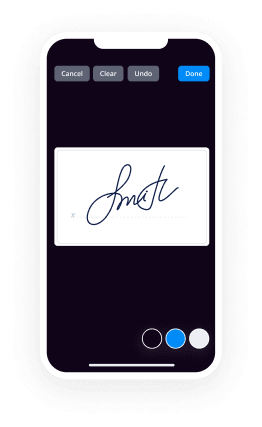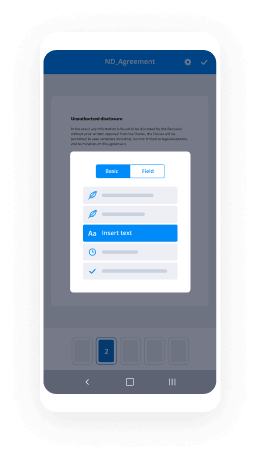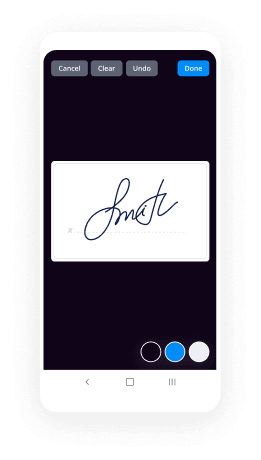Signature électronique vs. Signature Physique
- Démarrage rapide
- Facile à utiliser
- Support 24/7
Les entreprises qui pensent à l'avance dans le monde entier font confiance à airSlate pour le moment






Votre guide complet
De nos jours, vous ne trouverez probablement pas d'entreprise qui n'utilise pas les technologies modernes pour automatiser le flux de travail. Une signature numérique n'est pas l'avenir, mais le présent. Les entreprises d'aujourd'hui utilisant leur chiffre d'affaires ne veulent tout simplement pas arrêter les logiciels en ligne qui fournissent des outils avancés d'automatisation du traitement des documents, y compris la fonction de signature électronique contre signature physique.
Comment gérer la fonction de signature électronique contre signature physique airSlate SignNow :
-
Une fois que vous êtes sur notre site, connectez-vous ou enregistrez votre compte si vous n'en avez pas, cela ne prendra que quelques instants.
-
Téléchargez le fichier de données approprié ou sélectionnez-en un dans vos dossiers de bibliothèque : Documents, Archive, Modèles.
-
Grâce à la compatibilité du stockage basé sur le cloud, vous pouvez rapidement importer le document nécessaire depuis les clouds préférés avec presque n'importe quel appareil.
-
Vous découvrirez votre document de données ouvert dans l'éditeur PDF à jour où vous pouvez apporter des modifications avant de décider de continuer.
-
Tapez du texte, insérez des graphiques, ajoutez des annotations ou des cases à remplir à compléter plus tard.
-
Utilisez le bouton Ma signature pour signer vous-même ou placez des champs de signature pour envoyer la demande de signature électronique à un ou plusieurs destinataires.
-
Utilisez le bouton TERMINÉ lorsque vous avez terminé pour continuer avec la fonction de signature électronique contre signature physique.
La plateforme navigateur airSlate SignNow est essentielle pour augmenter l'efficacité et la performance de la plupart des processus de travail. La signature électronique contre signature physique est l'une des fonctionnalités qui peut aider. Utiliser l'application en ligne de nos jours est une nécessité, pas un avantage concurrentiel. Essayez-le maintenant !
Comment ça marche
Évaluez votre expérience
What is the physical signature
A physical signature is a handwritten mark or sign made by an individual to signify agreement or acknowledgment on a document. This traditional method of signing involves physically writing one's name on paper, which serves as a legal validation of the signer's intent. While physical signatures have been widely used for centuries, the rise of digital technology has introduced alternative methods, such as electronic signatures, which offer greater convenience and efficiency in document management.
How to use the physical signature
To use a physical signature, an individual must first print the document that requires their signature. After reviewing the content, they can sign the document in the designated area, typically at the bottom or an assigned signature line. Once signed, the document can be scanned or photographed to create a digital copy, which can then be shared via email or other digital platforms. This method ensures that the physical signature is preserved while allowing for easy distribution and storage of the signed document.
Legal use of the physical signature
Physical signatures hold legal significance in the United States, often required for various agreements, contracts, and official documents. The Uniform Commercial Code (UCC) and the Electronic Signatures in Global and National Commerce (ESIGN) Act provide guidelines on the validity of signatures. While physical signatures are legally binding, it is essential to ensure that the signer has the capacity to sign and that the document is executed in compliance with relevant laws. Understanding the legal implications of a physical signature is crucial for maintaining the integrity of agreements.
Steps to complete the physical signature
Completing a physical signature involves several straightforward steps:
- Print the document that requires your signature.
- Read through the document carefully to understand its contents.
- Locate the signature line or designated area for signing.
- Sign your name in the appropriate space using a pen.
- Make sure the signature is clear and legible.
- Optionally, date the document if required.
- Scan or take a photo of the signed document to create a digital version.
Examples of using the physical signature
Physical signatures are commonly used in various scenarios, including:
- Signing contracts for rental agreements or leases.
- Completing tax forms and other government documents.
- Finalizing legal agreements, such as wills or power of attorney documents.
- Authorizing financial transactions, such as checks or loan applications.
- Signing employment contracts and HR-related documents.
Security & Compliance Guidelines
When using physical signatures, it is essential to adhere to security and compliance guidelines to protect sensitive information. Ensure that signed documents are stored securely to prevent unauthorized access. Additionally, consider using secure methods for sharing signed documents, such as encrypted email or secure file transfer services. Compliance with relevant regulations, such as the Health Insurance Portability and Accountability Act (HIPAA) for medical documents, is also crucial to maintain the confidentiality of personal information.
Digital vs. Paper-Based Signing
While physical signatures involve traditional pen-and-paper methods, digital signing offers a modern alternative that enhances efficiency. Digital signatures can be completed electronically, eliminating the need for printing and scanning. They provide benefits such as faster turnaround times, reduced paper usage, and easier storage and retrieval. Understanding the differences between digital and paper-based signing can help individuals and businesses choose the most suitable method for their needs.
Obtenez dès maintenant des signatures juridiquement contraignantes !
-
Meilleur ROI. Nos clients obtiennent un ROI 7 fois en moyenne au cours des six premiers mois.
-
Échelle avec vos cas d'utilisation. De SMB à moyen marché, airSlate SignNow fournit des résultats pour les entreprises de toutes tailles.
-
Interface utilisateur intuitive et API. Signez et envoyez des documents depuis vos applications en quelques minutes.
Signature en ligne de la FAQ
-
What is a physical signature and how does it differ from an electronic signature?
A physical signature is a handwritten mark made by an individual on a document, typically using a pen. Unlike electronic signatures, which are created digitally, physical signatures require the physical presence of the signer. Understanding the difference is crucial for businesses transitioning to digital solutions like airSlate SignNow. -
Can I use airSlate SignNow to create a physical signature?
While airSlate SignNow primarily focuses on electronic signatures, you can upload a scanned image of your physical signature to use in your documents. This allows you to maintain a personal touch while benefiting from the efficiency of digital signing. It's a great way to blend traditional and modern signing methods. -
What are the benefits of using airSlate SignNow over traditional physical signatures?
Using airSlate SignNow offers numerous benefits over traditional physical signatures, including faster turnaround times, reduced paper usage, and enhanced security. With electronic signatures, you can sign documents from anywhere, eliminating the need for physical presence. This streamlines your workflow and saves valuable time. -
Is airSlate SignNow compliant with legal standards for physical signatures?
Yes, airSlate SignNow complies with all legal standards for electronic signatures, making them as valid as physical signatures in many jurisdictions. This compliance ensures that your signed documents are legally binding and recognized by courts. You can confidently use airSlate SignNow for all your signing needs. -
What pricing plans does airSlate SignNow offer for businesses needing physical signature solutions?
airSlate SignNow offers flexible pricing plans tailored to meet the needs of businesses of all sizes. Each plan includes features that support both electronic and physical signatures, ensuring you have the tools necessary for efficient document management. Visit our pricing page for detailed information on each plan. -
Can airSlate SignNow integrate with other software for managing physical signatures?
Absolutely! airSlate SignNow integrates seamlessly with various software applications, enhancing your ability to manage both electronic and physical signatures. This integration allows you to streamline your processes and maintain a cohesive workflow across different platforms. Check our integrations page for a complete list of compatible applications. -
How secure is my information when using airSlate SignNow for physical signatures?
Security is a top priority at airSlate SignNow. We employ advanced encryption and security protocols to protect your information when using our platform for physical signatures. This ensures that your documents remain confidential and secure throughout the signing process.
Votre guide complet
Solution eSignature de confiance
Rejoignez plus de 28 millions d'utilisateurs airSlate
Obtenir plus
- Augmentez la conformité avec les eSignatures : pouvoir ...
- Augmentez la conformité avec les eSignatures : ...
- Augmentez la conformité avec les eSignatures : pouvoir ...
- Commencez avec eSignature : programme pour remplir des ...
- Transformez un PDF en un Document Interactif : ...
- Commencez votre parcours de signature électronique : ...
- Augmentez la conformité avec les eSignatures : signez ...
- Commencez votre parcours de signature électronique : ...




















